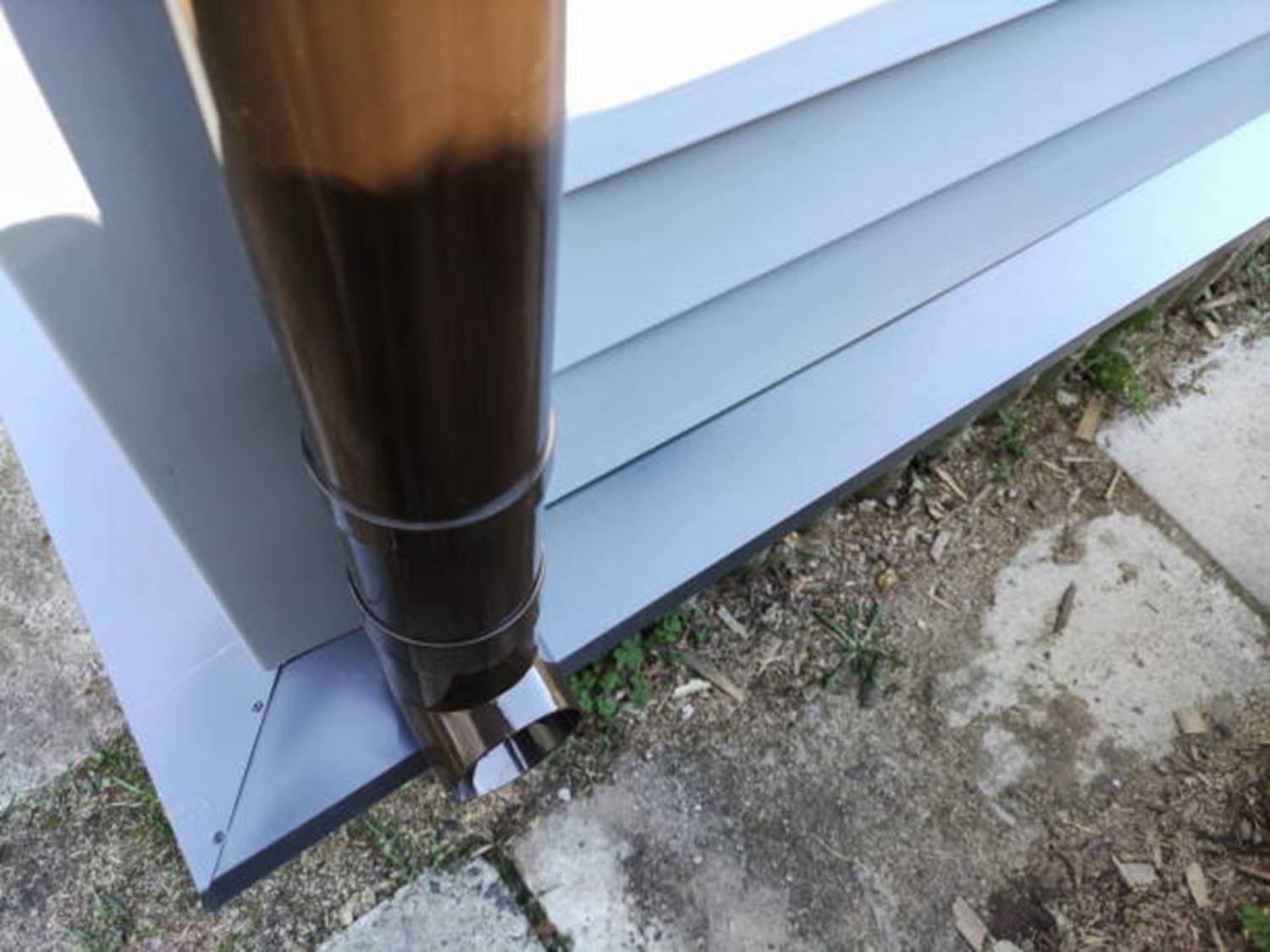An effective gutter system is a critical part of protecting your property from water-related damage. It collects rainwater from your roof and directs it away from your home’s exterior trim and foundation. Unfortunately, most homeowners have different gutter systems installed but fail to manage the runoff effectively. Could it be they ignore or have inefficient downspout extensions installed?
Sure, gutters and downspouts help control roof runoff. However, if the melted snow or rain water isn’t carried far away enough from your house, it will pool near the foundation. It can also seep into your crawl space or basement. A sure way to prevent such water-related issues is to connect your downspouts to drain pipes or downspout extensions that lead far from your house.
What are Downspout Extensions?
Also known as gutter extensions, downspout extensions are attachments placed at the end of downspouts to direct water away from a property. The entire gutter system is crucial for your property. It ensures rainwater doesn’t pool around your home and causes mold and moisture-related issues on the inside. Also, it protects your roof and siding from water-related damage.
Water and debris in your gutters flow through the downspout and empty around your home. However, this can create puddles of water and mud around your house. And this is why gutter extensions are essential. Sure, you can ignore the extenders and let the water pool form. But this will not only be visually unpleasant but also erode your lawn.
If not addressed on time, a flooded basement and water damage in your crawl space will ensue. Cracks may begin to form in your home’s foundation. This can cause extensive damage and related costly repairs. It can also compromise the structural integrity of your home. It’s recommended to install gutter guards (to keep your gutters clog-free) and add the right downspout extender to direct rainwater away from your property.
How far should a Downspout Extend from your House?
In a world where all properties are built the same, the answer is four feet. The downspouts must extend a minimum of four feet away from a house. As you know, not all homes are the same or built on the same site. This is why there’s no universal answer to this question. So, how far should downspout extensions reach? The answer is – it depends.
That’s right; it depends on the quality and type of the soil surrounding your house. It depends on the area where your home is built and its slope. Other seemingly minor factors like local building codes and climate will also determine how far your downspouts should extend. So, you will need practical downspout extenders when installing your gutter drainage system. To determine the right downspout extenders for your property, consider the following;
Everything will always roll downhill
An important factor to consider is the ground slope around your home. Even on a flat area, the strip of ground against your home’s foundation must gently slope away. However, this slope will not affect your drain pipes.
Figure out the general landscape slope, then use it to your advantage. It is an effective way of directing water a safer distance from your house and preventing damage to your foundation, siding, and basement. Consider extending your downspout to the slope crest that falls away from your home. This way, water from your gutters and downspouts will continue to flow away from the home.
Suppose your downspout extenders drain rainwater right into the base of a slope angled toward your home’s foundation. In this case, the water will do a U-turn after it leaves the downspout and pool around the foundation. And that’s what you were trying to avoid when you installed gutters around your property.
If you are unsure of the general slope, mimic heavy rain using a garden hose to track the water path the moment it lands near your home. Direct the water stream from the hose to the area where you want your downspouts to end. Watch the water path and note the flow direction. Alternatively, call an expert to avoid costly mistakes when extending your downspouts.
Groundwork
It’s equally important to consider the type of soil surrounding your home. Pay attention to the clay molecule shape and how these particles organize themselves the moment they come into contact with water.
Suppose you have high clay content in the soil surrounding your property. In that case, you shouldn’t worry about excess water absorption and leaking into your house. So you can have shorter downspouts. But this excess water needs to flow somewhere. That’s why you should direct it away from your home.
Sandy soils often hold water more than clay soil. If your downspouts pour water in an area with more sandy soil, it likes to pool if there’s no slope. In this case, you should extend your downspout further away from the house. Generally, you should consider the soil type around your home and how it behaves when it rains.
Remember the Building Codes
The local building codes will provide information about the legal requirements for the recommended downspout length. It’s in your best interest to ensure your property is compliant with such legal requirements.
Remember, local building codes often take into account various factors, such as the local climate and predominant soil type. Getting to know them is a better way of understanding the ideal downspout extension for your home.
Extending Gutter Downspouts
There are different types of downspout extensions you can choose from. Note that they all perform the same task – directing rainwater away from your home. However, each downspout extender has advantages and limitations.
1. Roll-Out Downspout Extenders
These downspout extenders are designed to automatically roll out whenever it rains and disperse the rainwater away from your home. Once the rain stops, it should roll back up – like a party blower, but for your home’s downspouts. The principle behind their operation is simple. When rainwater flows into the downspout, its pressure causes the extender to unroll and divert the rainwater away from your house. Once the flow ceases and pressure drops, the sleeve automatically rolls back to its original position.
Most of these downspout extenders are easy to install, lightweight, and stretch for a safe distance from your home. During heavy rains, roll-out downspout extenders can effectively divert a lot of rainwater away from your house.
However, these roll-out sleeves have some limitations. Despite their easy installation, they may not be made of the best quality plastic. That means tears can easily happen. Also, the sleeve may not even extend fully during light rains.
2. Flip-Up Downspout Extenders
Flipper extenders, also known as hinge extenders, are simply a section of a downspout with a hinge attached. That means you can flip this section up and out of the way when you don’t need it. Unlike flexible extenders, these downspout extensions are exclusively made of metal. So, they are more durable than plastic extenders and can be painted to match your home’s exterior.
Remember, this downspout extension type is ideal for property owners who prefer a discreet option that won’t change their landscape. However, these extenders require manual operation, which can be inconvenient for some property owners.
3. Flexible Extenders
Most flex extenders are corrugated plastic pipes that can be bent to direct rainwater away from your home’s foundation and lawn. You can buy adapters to connect a standard drainage pipe to your downspout to create a long gutter extension. Also, you can use perforated drainage pipes to distribute the water evenly over areas you need to water, like your lawn.
The top advantage of flexible downspout extenders is their versatility – you can easily adjust them to navigate various obstacles or landscaping. They are also affordable and easy to install. However, they often degenerate over time, especially in harsh weather conditions. So, you may need to replace them more often than other downspout extensions.
4. Underground Diverters
Underground diverters, also known as drain tiles, are a permanent solution that keeps water completely out of sight. These buried drain pipes reroute the downspout into a buried drainage pipe that leads water away from your property. Some homeowners even opt to have the water rerouted to a garden or dry well.
While underground diverters are the most discreet and potentially the most effective way to manage water runoff, they are also the most costly and complicated to install. They require digging trenches and properly sloping the pipes to ensure effective water flow. Regular maintenance is also required to prevent blockages from leaves and debris.
5. Decorative Splash Blocks
These are rectangular channels intended to disperse the rainwater coming from your gutters and downspouts. They serve a dual purpose – divert water away from the house while enhancing the property’s aesthetic appeal.
Decorative downspout extenders range from decorative options to basic, metal or plastic splash blocks, which may be narrow or wide. Whichever you choose, these downspout extension options do a great job of ensuring rainwater doesn’t seep into your foundation or basement. The key part of the installation process is ensuring your yard is graded appropriately. And a word of advice: ensure the open end is pointed away from your home.
Other Downspout Extension Ideas
Aluminum Extensions
An aluminum extension is a popular downspout extension idea for a good reason. They are affordable, require low maintenance, and are easy to install. However, they may be unsightly and cause access issues. So, it’s best to install them in areas where they can be hidden in bushes or other similar landscaping features.
Plastic Downspout Extenders
These downspout extenders are more affordable than those made of aluminum. They connect to the bottom of downspouts. So they will not detract as much from your yard’s appearance. However, they present a tripping hazard, and you cannot hide them entirely. Some plastic extenders may be flat and though they still pose the tripping hazard, their low profile is less risky.
Rain Barrel System
A complete rain barrel system comprises a large barrel that collects all the rainwater from downspout diverters. This is an eco-friendly system, which is great in areas where drought is a problem. The water collected and stored in the barrel can be used to irrigate landscaping.
Some property owners may require downspout extension systems more elaborate than splash blocks or roll-out sleeves. You can choose to extend your downspout system down to an underground pipe into a dry well or underground drainage system. Alternatively, you can collect the rainwater in a rainwater catchment system for domestic use.
Conclusion
For your home’s gutter system to work efficiently, your downspouts must drain to an area far enough away from your home. Most properties benefit from at least 4 feet of clearance from the drainage area. This can be accomplished through the installation of downspout extensions. While these come in many varieties, it’s best to consult a professional to choose and install the right downspout extender for your property.
FAQs
How far should a downspout extend from your house?
At least 4 feet away from your house to prevent runoff from causing foundation issues, basement flooding, mold growth, and other forms of water-related damage. You may want to extend your downspout further if your area generally slopes towards your house or live in a region that receives heavy rain.
What’s the best downspout extension?
There are different downspout extension ideas you can try, many of which are inexpensive and easy to set up. Roll-out sleeves are best for preventing tripping hazards, barrel systems are eco-friendly in terms of drainage, and underground drainage pipes are considered the most efficient downspout extenders.
How do you extend gutter downspouts?
How you connect your downspout extension will majorly depend on the extension type you are using. Most options, like roll-out sleeves, slide over the bottom section of your downspout. You may need a downspout adapter to keep the extension attached. Complex and more effective options like underground drainage systems require a professional to measure and fit them in accordance with the local building codes.




